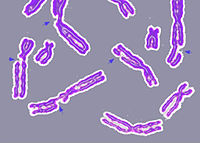
Photo from wikipedia
8-Oxo-7,8-dihydroguanine (8-oxoG) is the major base damage in the genomic DNA by exposure to reactive oxygen species. Organisms have evolved various DNA repair mechanisms, such as base excision repair (BER)… Click to show full abstract
8-Oxo-7,8-dihydroguanine (8-oxoG) is the major base damage in the genomic DNA by exposure to reactive oxygen species. Organisms have evolved various DNA repair mechanisms, such as base excision repair (BER) and nucleotide excision repair (NER), to protect the cellular genome from these mutagenic DNA lesions. The efficiency and capacity of BER and NER mechanisms can be modulated by the local sequence and structural contexts in which 8-oxoG is located. This graphical review summarizes the biochemical and structural studies that have provided insights into the impact of the microenvironment around the site of the lesion on oxidative DNA damage repair.
Journal Title: DNA repair
Year Published: 2020
Link to full text (if available)
Share on Social Media: Sign Up to like & get
recommendations!